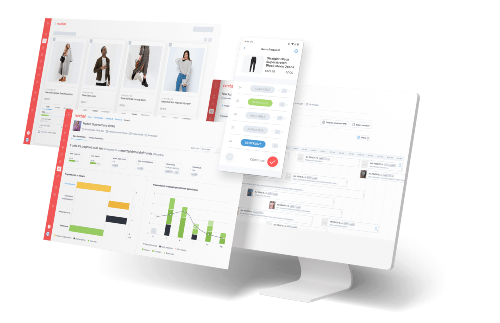
Panel takeaways: How a hyper-local approach to assortments enables customer centricity
Customer demand is trickier than ever to pinpoint and slipperier than ever to hang on to. So how can brands and retailers ensure customer-centric assortments at all times? We asked retail experts from Tendam and Aristocrazy, as well as industry commentator James Mooney, to give their thoughts and advice. If you missed the live discussion, you can view it full here, or continue reading for the main takeaways!
Why all the talk about customer-centric assortments?
Customers have always been important – what good is a product if no one wants to buy it? But today, they have to be at the center of assortment strategies. With access to more information, more channels from which to connect, and more options to choose from, customer loyalty is alive and to be earned rather than taken for granted.
According to Carlos Abellán, Data Analytics and Transformation Director of Tendam, it’s a question of freedom and access that’s making customer-centric assortments so important: “[Customers] buy online and if they don’t like what they see on your website, then they go to another website immediately…so even if you think it’s a great product, your competitor is next door – in the next tab…so you really need to listen to the customer and be prepared.”
On the other hand, the pandemic has also had a role in changing customer expectations. According to Sinead O’Keeffe, Product Manager at Aristocrazy, “Something that [the pandemic] has helped shift is customer centricity, because the product was still there during the pandemic, but once people were able to go back to stores, I think customers were looking for something other than product. They wanted something deeper. The connection with the brands is deeper, the customer experiences are deeper.”
Products will always be essential to success. But brands and retailers that focus on aligning them with constantly changing customer demands will strike the balance between offering customer-centric assortments and continuing to grow.
The role of AI in challenging top-down assumptions
Thanks to the power of AI and exponentially greater computing capacity, retailers can now work with an extreme level of data granularity. The insights they gather can be fed upward into decision-making as opposed to solely following top-down marching orders, to ensure customer demands are being heard.
Challenge preconceived notions and redefine high-level strategy
While top-down decision-making can help drive the business forward, especially in terms of defining global business elements like company objectives, pricing strategy, and others, the insights retailers can draw from granular, bottom-up data may tell a different story – one that’s worth listening to.
James Mooney, Brand Adviser and Retail Expert who has worked closely with major brands such as Topman, Primark, and Pimkie remarked on the gap that often appears between top-down decisions and bottom-up insights: “More successful businesses look at [assortments from the bottom up or at the hyperlocal level]…And yes, it might not marry up with what the top down approach is, but that’s the conflict and that’s the balance that you want to achieve between the two.”
Panelists agreed that these data-based insights have an important role in questioning preconceived notions about assortments, shaking up long-held assumptions, and helping to redefine high-level strategy. Or at the very least, providing the data that can spark conversations about it.
Mooney explained that it may be tempting to force down some generalized top-down decisions, the data might convince decision makers to do some rethinking “when you’ve got the chance to make that extra bit of margin and please the customer.”
Assortment flexibility and agility throughout the season
A dynamic market means that brands and retailers can’t afford to accept rigid plans and hope they work out. A bottom-up, hyper-local approach allows them to be agile from the very beginning, all the way through the end of the season.
Pre-season: Learn fast and make data-based decisions
Pre-season can set the scene for the rest of the season, so brands and retailers need to have a good grasp on expected demand in order to best ensure success. While of course no one has a crystal ball, retailers taking a bottom-up or hyper-local approach have the power to look into the current reality of demand and make decisions based on fresher data. In other words, they’re no longer limited to relying solely on last year’s sales or a gut feeling to get an idea of what performance is going to look like going forward.
Carlos Abellán said, “What a bottom-up approach and all this data allows you to do is to have more transparency and to learn as much as you can from what has happened in the recent past so that you can make decisions… For [Tendam], pre-season is important because as a fashion group we need to buy and forecast huge amounts of items in advance, therefore having a good view on where we are performing better or worse is super important.”
The power of AI automation and advanced analytics also makes it possible to run allocation projections even before the stock arrives from manufacturers for even further likelihood of success. Instead of waiting for stock to arrive at the warehouse, retailers can send waybills in advance, giving the warehouse more time to prepare and send the stock to stores, avoiding lag time that results in lost sales and extra manual work.
In-season: Make the best use of inventory, especially when things change
Then there’s the in-season. Weather, political and supply chain disruptions, influencers, and competitor behavior can render your original assortment plans obsolete quickly. But even minor shifts in demand can result in lost sales and lower margins.
Nailing assortment decisions means being able to decouple them from the buying process. For example, instead of taking whatever has been bought and allocating to traditional, static store clusters, retailers can work with dynamic groupings that are constantly being updated based on ongoing performance.
Nextail Head of Transversal Initiatives, spoke of the ability to assess and reassess assortment at the hyper-local level: “We can now see every detail of what happens every day in every store in every color. Let’s move away from A stores, B stores, C stores and focus more on what the customer is demanding in every store. That’s another way in which working with such granularity can help you align your inventory with expected demand in every store.”
Of course, it’s easier to offer customer-centric assortments when things are going “right”, but when things go wrong, flexibility is even more important.
Speaking of recent supply chain disruptions, Sinead O’Keeffe said, “Going to that granular level when something arrives later than it should or you know that you’re going to have less stock than you’d like in the future, it allows you to prioritize and make sure the product is exactly where it needs to be and you’re getting more profit instead of what you originally had planned.”
Reorder stock faster than ever
Bottom-up, hyper-local data-driven insights paired with automation also enable speed and inventory efficiency when it comes to reordering products.
Speaking of how the granularity of solutions such as Nextail’s Reorder empower Purchasing departments, Sinead O’Keeffe said, “We’ve been exposed to different kinds of supply chain problems and [Reorder] has allowed us to be a lot more reactive….Because we have that vision, that granularity, it has allowed us to react very fast. Normally, it might have taken us weeks to react to certain problems that we’ve encountered, here we were able to do it in days.”
Build the confidence for assortment innovation
While a top-down approach will guide global business decisions that may be translated down into assortment decisions, bottom-up and hyper-local intelligence often helps to provide a better baseline for these decisions to be made in the first place.
Data-driven insights enabled by a hyper-local approach can help retailers gain the confidence they need to request, suggest or implement change and innovation into their strategies such as reducing assortments, introducing products more frequently, and more.
James Mooney remarked, “Having worked in businesses that pitch rather than [accept] given plans, I think it definitely helps drive that innovation.”
With a real-time vision of reality and new opportunities identified by granular data, brands and retailers can make more efficient use of their stock and make changes faster and more flexibly instead of relying on a picture of performance painted with the broad brushstrokes of an overly top-down approach. All in the name of offering more customer-centric assortments at all times.
If you’re ready to take the next step in transforming your fashion retail operations, here are 7 essential considerations for what to look for in a merchandise planning platform.



